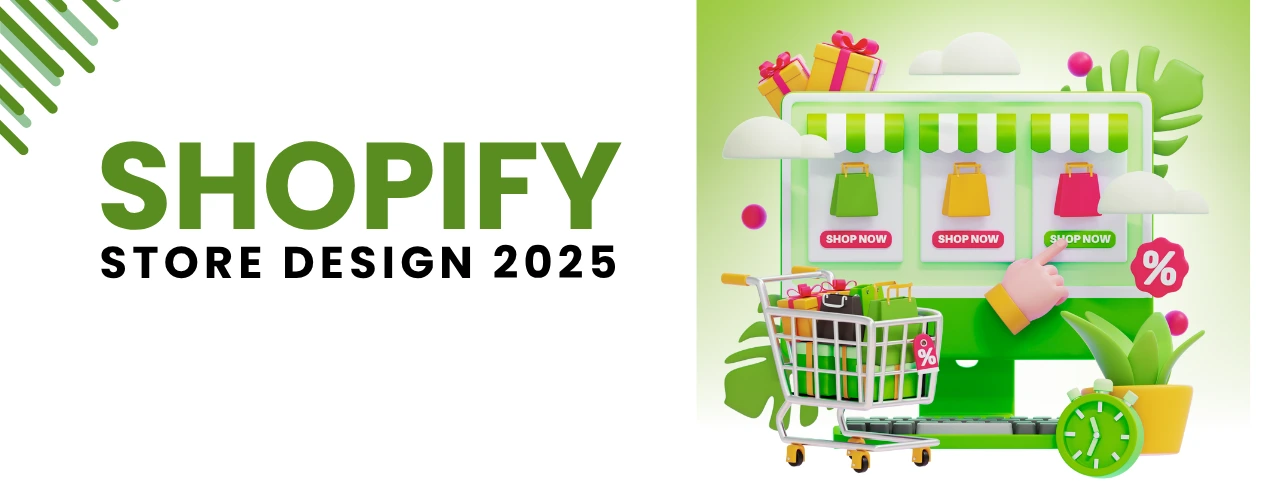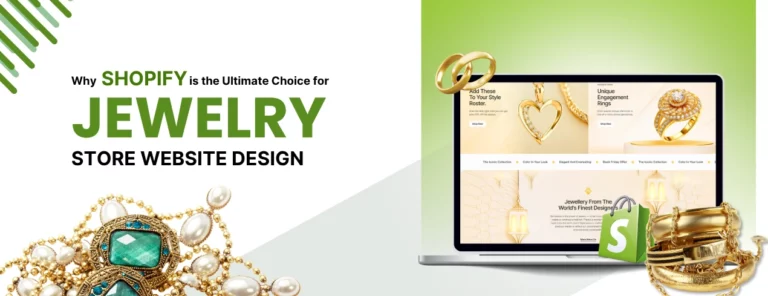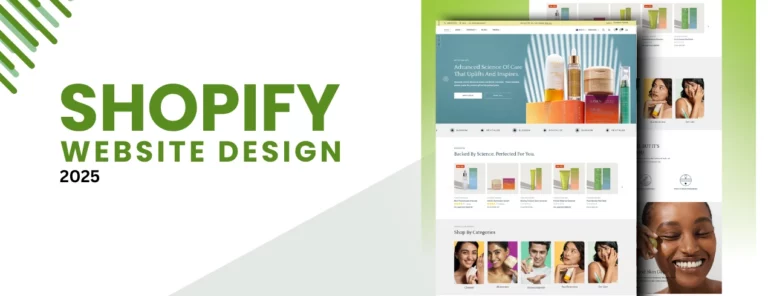As the year 2025 continues, it is increasingly becoming apparent that high-quality Shopify store design is no longer a mere advantage; it is a business necessity. Having more than 4.4 million active stores worldwide, Shopify is dominating the e-commerce industry, radically expanding the digital storefronts of entrepreneurs, startups, and companies alike. However, the mere presence of a store is not sufficient. The actual distinction? Your Shopify store design in 2025.
Studies indicate that 75% of online users evaluate the credibility of a business by the aesthetic experience of the business website, and that 94% of first-time impressions of users are related to design. To add to that, there are already over 70% of all e-commerce transactions being done through mobile commerce, which means that Shopify merchants have to design and create their websites with performance, clarity, speed, and, most importantly, trust.
This no-frills guide covers all that you need to know to start building or refine your Shopify store in 2025. Featuring all the best in design trends, homepage inspiration, real-life design examples, and tips, this is your detailed handbook to creating a successful Shopify store design.
Table of Contents
What is Shopify Store Design?
Shopify store design is the art and science of designing and scaffolding the aesthetic and functionality of your Shopify store, all the things your shoppers can see and work with, the home page layout, product page layout, navigation, typography, mobile responsiveness, and the checkout funnel and workflows. Essentially, it is the construction of user experience that will transform your visitors into loyal buyers. It is what your brand communicates visually, inspires trust, and takes your customers through the journey seamlessly, discovering and ultimately buying.
Key Elements of Shopify Store Design
No matter what Shopify store theme you use, free or paid, or whether you outsource your design work to a Shopify web design company, it all starts with some core elements:
- Homepage Design: Your storefront’s first impression must introduce your company and, along with highlights about your products, include a call-to-action (CTA) to generate clicks.
- Product Page Layout: It has product images, descriptions, reviews, price, and add-to-cart buttons. An efficiently designed product page will limit hesitation among buyers.
- Navigation & Menus: The menu bars, collection filters, as well as connection trails are intuitive enough to allow users to access the desired information rapidly.
- Brand Identity Elements: Fonts, color schemes, places where the logo is to be placed, and the general consistency of design will complement your brand’s tale.
- Mobile Optimization: As mobile commerce is dominating the market, your Shopify store today has to be fluid, turbo, and fingertip-friendly.
- Checkout Experience: The checkout process should be fast, non-distracting, and safe at every step of the way (cart to confirmation).
Quality Shopify store design is the sweet spot between form and functionality, enabling your store to look exquisite and functional.
Why is Shopify Store Design Important?

With the rapidly changing landscape of online business, your first impression, the virtual shop window, and the ultimate sales tool of your brand is your website. And in 2025, as digital attention spans are becoming even shorter, and the competition in the industry is increasing, Shopify store design is more imperative than before.
First Impressions Are Everything
Any new visitor will spend only 0.5 seconds deciding whether he/she is impressed. An untidy, disorganized, or underbranded store leads to immediate abandonment. Conversely, intuitive and polished UX, clean navigation, with high-quality visuals give a feeling of your store being smart, credible, and safe. 75% of consumers assess the credibility of a brand alone on the design of its website. This is why Shopify website design is a business asset.
Design Impacts Conversions
Buyer behavior is impacted by your store layout, call-to-action buttons, the psychology behind colours, and font sizes, too. An effective Shopify home page directs the visitor towards the best of the sellers. A well-thought-out product page will counter arguments and deliver conversions. An optimized cart helps avoid abandonment.
Studies indicate that enhancing the design of your site can increase your conversions by up to 30% and sometimes more than any ad campaign.
Mobile-First Matters More Than Ever
By the end of 2025, mobile traffic that goes through Shopify will exceed the 74% mark. Think about it, unless your store has a mobile-friendly UX and design, is responsive across all devices, loading speed is rapid, and has scriptable calls-to-action, you are losing sales. A mobile-first Shopify store design minimizes the frustrations of customers when scrolling and purchasing items. Responsive design is also beneficial to Google SEO performance and Core Web Vitals, which will naturally boost your store in rankings.
Good Design = Brand Differentiation
As thousands of Shopify stores launch every day, a custom and personalized storefront is your way of standing out. Your theme, imagery, structure, and tone add to brand recall and buyer loyalty. Gymsharps, Allbirds, and Kylie Cosmetics are all brands that employed the use of design as a strategic moat in the early days of their development, and Shopify enabled them to do so.
Design Supports SEO & Performance
An organized shop not only makes users happy, but it also makes Google crawl and index your content in a better manner. Performance and design are tightly coupled, and it is particularly important due to the changes in the algorithm introduced by Google in 2025 that are more focused on experience metrics.
A structured Shopify store design influences:
- Site speed
- Page hierarchy
- Accessibility
- Mobile usability
Put simply, when done properly, your Shopify store becomes a money-making machine. And when prepared with the assistance of a reliable Shopify web design company like DQOT Solutions, it can be your competitive advantage in the race of e-commerce race.
Latest Trends in Shopify Store Design for 2025
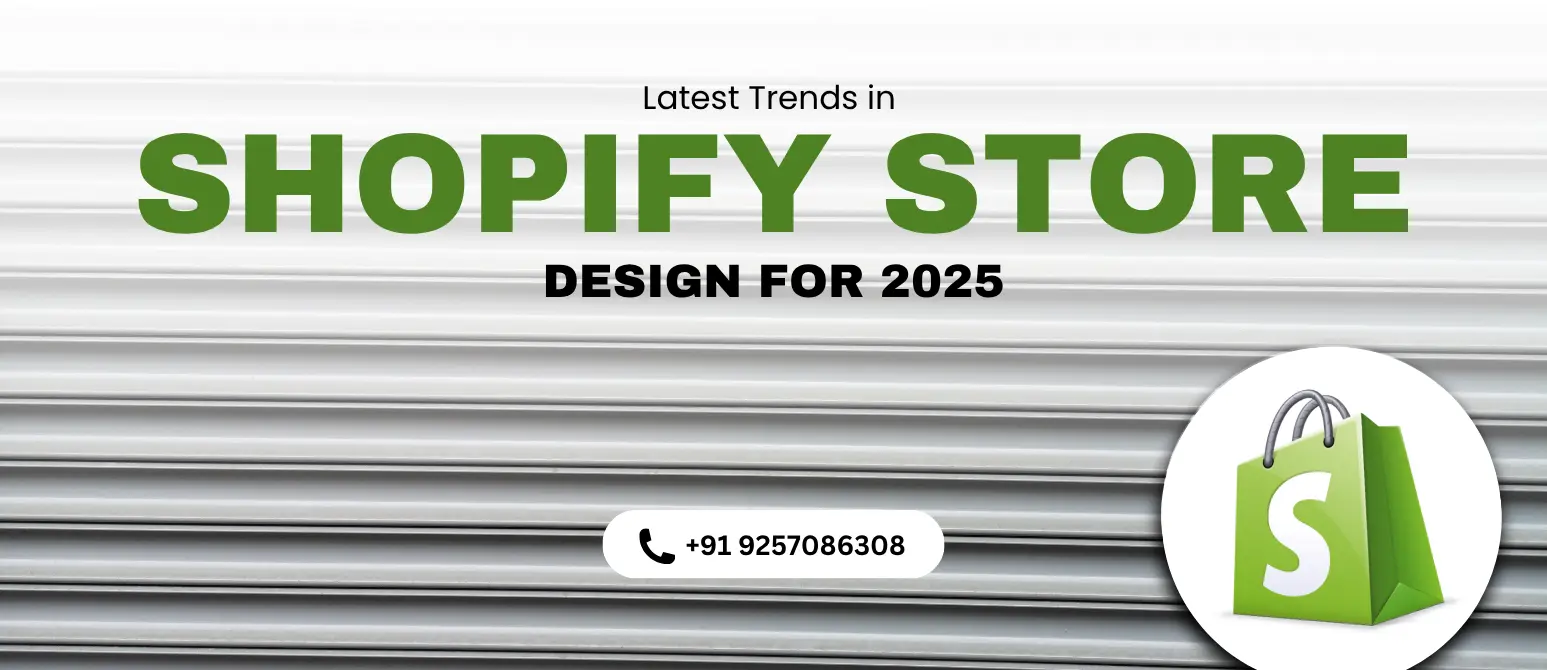
The Shopify store design in 2025 is no longer only about the looks of a website, but rather it is about an experience that brings conversion. As consumer demands are changing and Shopify is implementing new and powerful functions rapidly, retailers have to combine innovation, promptness, and customization at a pixel level.
Take a closer look at the most important design novelties and shifts that are changing the landscape of Shopify in 2025:
Shopify Online Store 2.0- More Flexibility, Fewer Limitations
The Shopify Online Store 2.0 is now the keystone of contemporary store design. This new architecture enables merchants to draw custom segments on each page with unparalleled flexibility. Not only are there no more restrictions as to the homepage, but blogs, landing pages, and product pages all can now be modified with ease.
AI-Powered Personalization Is Now Standard
Artificial intelligence (AI) is transforming a customer’s relationship with Shopify stores. The use of site intelligence features such as smart product recommendations, dynamic content blocks, and automated upselling is entering the design discourse. Personalizing homepages, carts, and post-purchase flows by user behavior can lift conversion by over 30%.
Headless Commerce & Lightning-Fast Storefronts
Headless Shopify store architecture is an increasingly popular approach where the front-end and the back-end are decoupled. That is why load speeds are extremely fast, custom UI/UX structures are possible, and one can incorporate strong CMS frameworks such as Contentful or Sanity. It is also compatible with Progressive Web Apps (PWAs) that introduce a native app-like performance to the internet.
Visual Storytelling with AR, 3D & Video
2025 is the year of immersive product experience. Consider 360 views of the product or augmented reality product tryouts, or video content that is directly integrated into a product page. They are not mere gimmicks. They also minimize the bounce rates and improve the confidence of buyers. With the support of multimedia provided by Shopify, this is now easier than ever.
Mobile-First Design Meets Core Web Vitals
Mobile is not more of a ‘priority’ anymore; it is mainstream. In 2025, all design choices will begin with mobile usability. It implies bigger touch points, tacky navigation, and real-time check-out capabilities. Additionally, with Google Core Web Vitals (CWV), mobile performance will become explicit in the SEO ranking.
Inclusive Design and Accessibility
Lastly, accessibility is a requirement. In addition to being ethical, high contrast colors, alt texts, and keyboard navigation are the best practices as well. New Shopify themes are better equipped and have built-in accessibility facilities, and custom designs that match international standards such as WCAG 2.1.
As you can observe, in 2025, functionality, speed, and personal relevance will become a trend in Shopify website layouts. Next, we are going to focus on the implementation part and how to turn these insights into reality with our guide on designing your custom Shopify store to win.
How to Design a Shopify Store in 2025?
The secret to a successful Shopify store design in 2025 is the ability to create a user experience that can eliminate all forms of mistrust amongst consumers, decrease as much friction as possible, and generate conversions. With the rise of competition and the changing consumer behavior, Shopify store designs should be creative as well as strategic.
Are you redesigning an old storefront or building one from the ground up? Either way, this is the guide to setting yourself up in the best way possible in 2025.
Choose the Right Theme: Free, Premium, or Custom?
But, in case you want to achieve a really unique user experience, or you have rather specific requirements in terms of design, then you want to go with a custom Shopify theme design. Each component of custom themes is made to serve you and your users, with no bloated code, no unnecessary constraints.
Homepage That Converts: Design With Purpose
The front page of your website is your shop window. In 2025, the best-performing Shopify stores start strong with:
- An assertive hero photo or video with an obvious value statement
- Navigational apprehensibility: consider mega menus, the concept of breadcrumb trails, and fixed (sticky) headings
- Social proof: live reviews, brand badges, and “as seen in” functionality
- Featured collections and best sellers
- Short path scroll and fast access links with mobile-first design
And always keep in mind that you should not tell everything on the homepage; you just have to mention the things that will make them want to dig more into the website.
Product Pages That Sell
The effective design of Shopify product pages would have a tremendous effect on conversion.
This is what a successful product page will consist of in 2025:
- Clean interface with zoomable high definition images and previews in 3D
- Transparency in pricing, inventory, and shipping information
- Stickiness of the button (Add to Cart), especially on mobiles)
- FAQ Accordion, Customer review, and trust badges
- Cross-sells: “You may also like” or e.g., “complete the look” functions
Take advantage of smart recommendation apps based on AI, such as Rebuy or LimeSpot, that get smarter as your user browses..
Navigation & Search: Make It Effortless
The real-life shopping pattern should be applied to your store navigation, making it either by categories, function, or by necessity. Make the exploration simple with the use of predictive search, filtering through tags (such as size, price, and material), and breadcrumbs.
Pro tip: Introduce an area like Shop the Look or By Occasion to make decisions and select the final product when it comes to the fashion or gift category.
Use Smart Shopify Apps to Enhance Design
In 2025, optimum designs will not be constructed individually.
Power up with apps such as:
- ‘PageFly’ or ‘Shogun’ to get a complex layout of pages
- ‘Fera.ai’ – animated Social Proof
- ‘Loox’ user-generated photos and reviews
- ‘Judge.me’ quick weightless review system
- ‘Hotjar’ user behaviour heatmap and design testing
Creating a successful Shopify store is part art and part data. When done correctly, your storefront, besides being amazing, takes shoppers where they want to be and makes it easy to convert.
Best Shopify Store Design Examples: Top Performers in 2025

Nothing can be more inspiring than the real-life examples when it comes to Shopify store designs. As of 2025, the most successful Shopify stores are combining striking images with streamlined user interfaces and blazing speeds to beat the competition. Regardless of whether you are in fashion, wellness, food, or home goods, you can learn valuable lessons by examining how others are doing what they are doing in their businesses, studying strategies about their approach, and observing what works and why.
The following are some of the most impressive examples of Shopify website designs across the industry, decoding what makes them so outstanding in the contemporary environment.
1. Allbirds
Allbirds is an eco-conscious shoe company that is exceptionally competent in minimalistic Shopify store design. Big white space, clear typography, and well-considered imagery enable the product to talk about itself on the site. Navigation is spot-on, and mobile UX is perfect. They also offer animations, sticky CTAs, and a carousel of their items, which loads quickly, to make shopping light and easy.
Why it works:
- Simple, easy-to-scan formatting and quick imagery display
- Eco-friendly messages in tandem with design style
- An interface that is mobile-first and lets users know where to filter products
2. Haus
The contemporary apéritif brand Haus provides an immersive Shopify website experience of purchasing its product, beginning with the landing page and all the way to the checkout. The brand uses big lifestyle images, animated effects, and big fonts to make each page feel like a magazine layout. They publish educational materials and subscription packs on their homepage, an excellent case of editorial storytelling mixed with e-commerce functionality.
Design highlights:
- Scroll-based animation & overlapping images
- Modular product displays emphasizing lifestyle
- Butter-smooth compatibility of the shopping cart and bundled contents
3. Thinx
The brand best known for producing reusable period underwear, Thinx, follows a conversion-oriented strategy of designing a Shopify store. Clear calls-to-action, product education, and community-based trust signals are its front runners. The brand has an excellent interactive design, where users can find the appropriate product through a quiz-type product finder, which is an emerging trend in 2025.
What stands out:
- Sticky top bar and CTA button for conversion ease
- Educational panels right on the product page
- High-contrast accessibility-focused design
4. Hiut Denim
This small company that produces jeans introduced the concept of storytelling into every pixel. The Shopify website design at Hiut Denim resembles the analog age of classic production. The use of video interviews of creatives who work behind the scenes, storytelling product pages, and fonts inspired by analog-based signatures makes the site an extension of the brand’s philosophy.
What to learn:
- Story navigation and the distinctive tone of the brand
- Process and quality pictures
- The sense of typography that is unique and natural
5. Bamford
The luxury Shopify store design created by Bamford is an e-commerce design masterclass. The design is minimalistic, free, and extravagant, with extensive images, pale colors, and relaxing animation. It is not cluttered with the mass of the text, and one can see the brand identity come through in all the parts.
Key design notes:
- Navigation based on scroll and emphasis on the products
- Slimline layouts customized to those who shop the best
- Special mobile experience of time-strapped purchasers
Inspired yet? These websites demonstrate that the principle of the Shopify store design in 2025 is related to clarity, connection, and conversion. Intended to have an editorial touch of finishes or product-centric minimalism, regardless of the purpose, the above examples can influence the design of your Shopify website.
Shopify Homepage & Product Page Design Trends for 2025
Your home page and your product pages are your online storefronts that would convert your visitors into your customers or drive them away. Shopify homepage layout inspiration in 2025 is dominated by an understanding of how to organize layouts and communicate, tell stories, optimize layouts to be mobile-friendly, and personalize delicately. Meanwhile, designing Shopify product pages has everything to do with support in making a decision, providing a visual reassurance, and convenience.
So, what are the most influential trends of these important pages, and how can you use them to create a Shopify store that sells like it looks? Let us take a closer look.
Shopify Homepage Design Trends🏠
Your elevator pitch is the home page. Best Shopify homepages have a couple of common features in 2025:
1. Modular Layouts with Clear Hierarchies
The era of scrolling is gone. Modular grids that consist of a combination of image cards, short texts, and product highlights are applied to today’s homepages. Such layouts assist in directing the eye of the user to what matters most within seconds, whether it is a best-seller, seasonal drop, or a key value.
2. Bold Hero Sections
The majority of the top Shopify websites start with a full-screen banner (usually animated or video) and with a strong CTA. The title itself makes the meaning of the store extremely clear. Case in point, “Clean Backed by Science Skincare.” This is then followed by a Shop “Now Button”, not “Learn More”.
3. Personalization Elements
In 2025, the dynamic aspects (such as the product recommendations or popups depending on returning visitors) are becoming the norm. AI-based blocks on the homepage are already adapting to past purchases or patterns of browsing.
4. Social Proof & Trust Signals
Review snippets, badges of trust, and as seen on carousels are reassuring. There will be even more real-time notifications (Sarah in New York City just bought…) integrated using the Shopify website apps, such as Fera or Proof.
5. Mobile Optimization First
More and more brands are building out homepages on mobile first so that they can guarantee speedy loading times, sticky headers, speedy carousels, and tappable CTAs. Mobile-first indexing is now the first priority of Shopify, so design it accordingly.
Shopify Product Page Design Trends📦
Your product page is your salesman. The best Shopify product pages in 2025 have three functions: they inform, persuade, and eliminate doubt.
1. 3D Visuals & AR Previews
You are likely to encounter more multimedia, such as 360 spins, animated AR (try before you buy in fashion, furniture, or beauty), and embedded “how to use the product” videos.
2. Sticky “Add to Cart” Buttons
Sticky CTAs that stay on as the page is being scrolled through, especially on mobile, are shown to increase conversions.
3. Trust-Building Sections
Shipping/Returns tabs, FAQs, and verified reviews, each section under the fold is devoted to keeping anxiety low and imparting value.
4. Product Bundles & Upsells
Most Shopify product page designs currently include bundling logic- “Buy with” or “They Frequently Bought Together” nudges can drive up average order value. The best apps are Bold Bundles or ReConvert.
5. Smart Product Filtering
Particularly valuable to stores with large SKUs, filters, and variant selectors (size, color, material) are being redone to be easier to use and have better touch support.
Confused about how to bring these ideas into your store? DQOT Solutions creates Shopify websites that not only look beautiful, but are coded to be more profitable and quicker.
Mobile-First Shopify Design: Tips for Seamless Shopping on Any Device
For 2025 alone, more than 74% of all traffic on Shopify was generated using mobile devices, and the figure keeps rising. Now that the shoppers are able to browse, compare, and even make their purchases on the go, a mobile-first Shopify store design is no longer an option but the foundation of your online store.
The following are the best mobile UX guidance and design workarounds to make your store not just mobile-friendly but also mobile-optimised to work better and increase profits:
1. Design for Thumb Zones
Most mobile users navigate using their thumbs, which means CTA buttons, filters, and search bars must be placed within easy reach of natural thumb movement. Elements like “Add to Cart” and “Buy Now” should always be sticky on the screen or anchored in a mobile-friendly floating bar.
2. Simplify Navigation and Filters
Forget the 10-option mega menus. A mobile Shopify menu should be streamlined and context-driven. Use expandable accordion menus and prioritized collections. Also, product filtering on mobile should allow tap-based filtering, rather than cumbersome dropdowns.
Pro Tip: Consider installing Shopify Smart Search apps that give the user predictive suggestions that speed up searching products, especially on a small screen size where typing may be a problem.
3. Optimize Visuals Without Compromising Quality
High-res pictures stimulate interaction, and they should be optimized for mobile speeds. Optimize your images to use WebP formats, lazy load, and the built-in Shopify CDN to ensure that the mobile store loads in less than 3 seconds, which is the standard of low bounce rates.
Pro tip: Videos and autoplay for mobile users should be limited to save bandwidth and enhance performance.
4. Mobile Checkout: Reduce Friction
Mobile cart abandonment is still a major challenge. To combat this, ensure your checkout process is clean, fast, and intuitive. Shopify’s native one-page checkout in 2025 is optimized for mobile, but you can go further:
- Enable Shop Pay, Apple Pay, and Google Pay
- Autofill address and payment fields
- Offer progress indicators to show steps left
- Fast checkouts = higher conversions.
5. Use Sticky Support Tools
On mobile, the assistance of the help icons, live chats, and support FAQs should be easily accessible. Such tools as Tidio, Gorgias, or Zendesk Chat fit seamlessly in Shopify stores and provide instant assistance more especially for high-value purchases or people outside your country.
Bonus Tip: Test Everything on Real Devices
Test the design of your store prior to going public on different devices, iPhones, Androids, tablets, and foldables. BrowserStack or Shopify store theme previewers are useful, but there is nothing quite like a real tap-through to spot bugs or spacing issues.
Why Choose DQOT Solutions for Shopify Store Design in 2025?
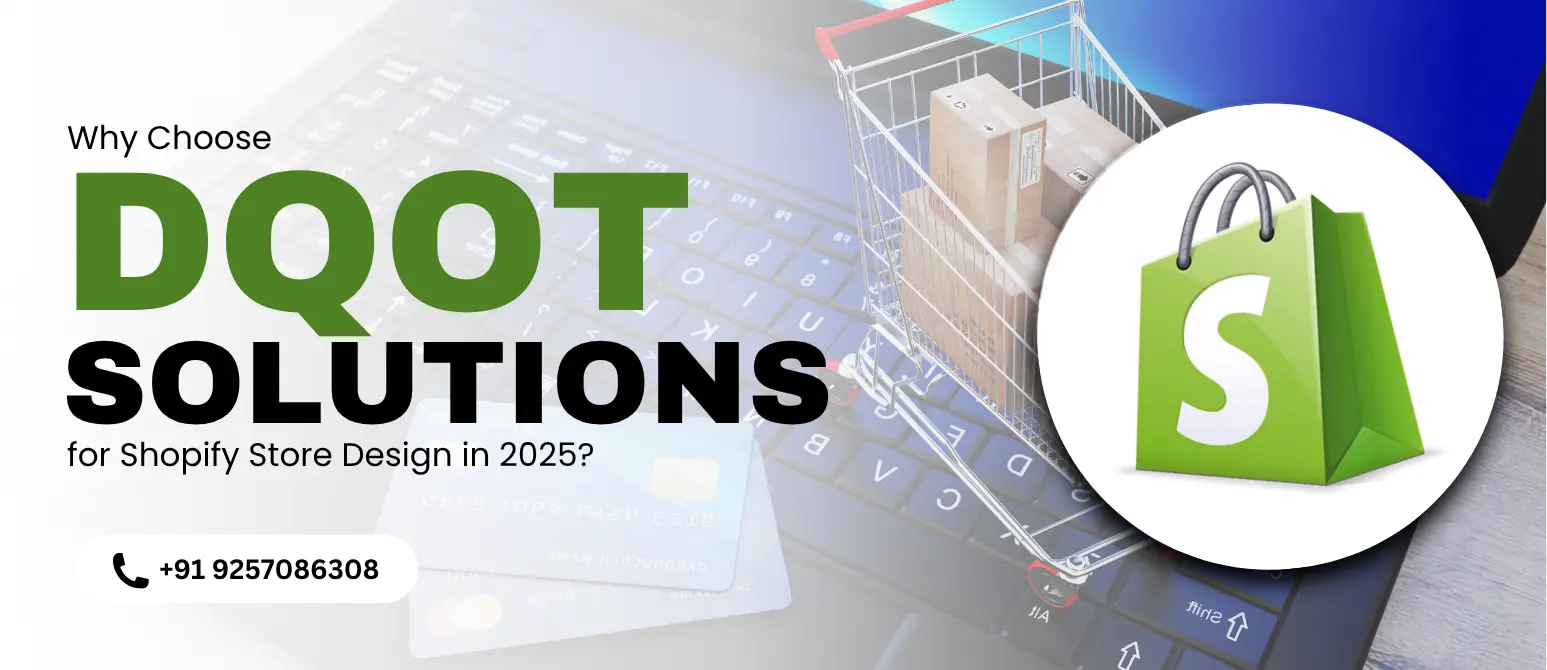
Getting the right partner is the first step in becoming the uncontested leader in powering your vision into a leading Shopify store in 2025. Be it opening up a new brand, re-designing an existing under-performing shop, or going global with e-commerce, DQOT Solutions is the leading Shopify store design firm dedicated to excellence, innovation, and is able to demonstrate measurable returns.
This is why modern businesses count on DQOT Solutions to provide the finest Shopify store design services and strategic, quick, and scalable features within.
Custom Shopify Store Design – Built for Your Brand
Not all businesses are the same, and your store need not be either. At DQOT Solutions, all Shopify jobs start with an analysis of your audience, product, and your special goals. Not only do we create custom Shopify themes that are perfect to the pixel, but they are also optimised to perform and convert. Whether it is homepage wireframes or product page UI/UX, all the decisions are taken with the user journey of your clients in mind.
Speed, SEO & Scalability – a Standard
Aesthetics is not the only thing with which our Shopify design approach is concerned. Our stores are lightning fast, SEO-compliant, and future-proof. Thanks to Shopify Online Store 2.0 and new development stacks, our storefronts now load in less than 2.5 seconds, leading to a 30 to 40% reduction in bounce rates.
All our designs are mobile-first, compliant with WCAG 2.1 accessibility standards, and Google Core Web Vitals optimised, so you can win both in the SERPs and revenue.
Full-Service Shopify Solutions Under One Roof
We offer end-to-end Shopify e-commerce web design services, be it storefront strategy, user interface/user experience audits, application integrations, branding, and even after-launch support. This eradicates the problem of dealing with many vendors and guarantees that design, development, and marketing are aligned.
Looking to get a quick redesign or migration from WooCommerce, Wix, or Magento? DQOT Solutions supports complete re-platforming and no data loss design carryovers.
Shopify Apps & AI-Powered Personalization
We not only uphold good design but also introduce the tools that yield growth. We are Shopify AI Specialists who provide smart recommendations, personalized shopping experiences, personalized paths to purchase, and tools that improve average order value and retention rates.
Product quizzes, real-time upsells, and loyalty integrations, we make the stores that scale with you.
What Clients Say
Our customers and clients continuously compliment on our responsiveness, design experience, and targeted results. Customers report increased conversions, decreased bounce rates, and improved customer interaction even in a few weeks of opening their new store.
“DQOT Solutions, along with redesigning our Shopify site, redesigned our customer experience. We saw a 52% increase in mobile conversions within a month.” – Aakash M., Founder of a D2C skincare brand.
Ready to build a Shopify store that works for your business? Let DQOT Solutions bring your e-commerce vision to life.
Final Thoughts on Shopify Store Design 2025
In 2025, Shopify stores are dynamic, intelligent, and very user-centered. Where mobile use is dominant, competitors are getting stronger and customer demands are increasing than ever before, your store design must be not only appealing in appearance, but it is a matter of performance, personalization, and brand confidence.
Does not matter whether you are building a store, moving to a new platform, or simply want to re-design and convert better; still, the principles remain the same: clean UI, lightning-fast loading speed, mobile-first approach, and narrative-driven layouts. Then add a splash of AI-driven personalization, immersive visuals, and conversion-centric apps, and there you have what you need to trade blows in the epoch of the next-generation e-commerce.
However, the best ideas require professional implementation. This is where the right Shopify design partner can be your saviour.
Why Design with DQOT Solutions?
At DQOT Solutions, it is not only about coding pretty pages; it is about designing e-commerce experiences that sell. Not only will all your stores be designed on a mobile-first basis and feature a homepage hierarchy and conversion-optimized custom Shopify theme, but they will be ready to scale from the start.
We combine pure creativity with data-driven strategy to make sure that your Shopify storefront is not just another template; it becomes a digital portal of your brand, designed to convert, grow, and generate hype.
As one of the most trusted Shopify web design companies in 2025, DQOT brings:
- Industrial tested and verified performance regardless of the size of the stores
- Knowledge of headless commerce, AR implementation, and custom UI
- Short turnaround time, scalable infrastructure, and after launch back-up
Ready to Build Your Dream Store?
With the sheer number of templates available, it should be clear that the cost of templates minimizes the benefits of having them. If you truly want to create a Shopify store that makes sales, earns loyalty, and is beautiful to look at, stop settling on templates. Choose a Shopify web development agency that knows both growth and innovation.
So let us design your future storefront. Contact DQOT Solutions now. Your brand is exceptional enough to warrant extraordinary results.\
Read More: Why Shopify is the Ultimate Choice for Jewelry Store Website Design: Templates, Features, and Costs
FAQs About Shopify Store Design 2025
The following is a list of the most commonly asked questions related to Shopify store design, particularly by entrepreneurs and brands who are looking to make their next big shop in 2025.
A conversion-optimized, phone-first approach is the best means of designing a Shopify store in 2025. Begin with the selection of a versatile theme (Online Store 2.0 template is one of the examples), pay attention to the easy navigation, effective visuals, and sticky CTAs. Buy extensions such as PageFly or employ a Shopify web design agency such as DQOT Solutions to design a unique theme suitable for your brand.
Website Design – The cost of professional Shopify website design services can vary between $1,500 – $10,000+, depending upon the complexity of the work, level of customization required, and integration. The price is higher due to custom themes, complex user experience flows, and application integration, but at the same time, ROI is increased. DQOT Solutions provides packages to fit startups and upscaling businesses.
Elements of a high-converting Shopify home page consist of a good value proposition in the hero area, collections on the home page, social evidence, simple navigation, and mobile responsiveness. Clear visual hierarchy is also essential, and the visitor needs just a few seconds to follow the visual cues to click further.
Yes, with a custom Shopify theme design, you have complete freedom of UX, performance, branding, and functions. Although templates are a fast and effective way of getting started, custom themes provide faster loading time, improved SEO, and higher conversion rates, particularly when developed by a professional firm such as DQOT Solutions.
The optimization of the mobile is essential. In 2025, smartphones will provide more than 70% of all the traffic, so your store will need to be fast, with easy navigation and tap-friendly CTAs. A Shopify mobile-first design will decrease your bounce rates and boost conversions by more than 30%.
Yes. An expert Shopify design firm could redesign your storefront without losing your product database, order history, and customer accounts. At DQOT Solutions, we have redesigned stores with zero data loss and very little downtime.
The best apps are: PageFly (drag-and-drop page builder), Loox (reviews display), ReConvert (optimization of the thank you page), Fera (live sales notification), and GemPages (complicated page builder). Another thing that DQOT does to improve UX is the development of customized app integrations.
Monitor core analytics such as bounce rate, time on site, cart abandonment, mobile speed, and conversion rate. Tools like Hotjar, Google Analytics, and Shopify reports provide excellent insights. DQOT Solutions also provides design audits to reveal weak points and improve your stores.


